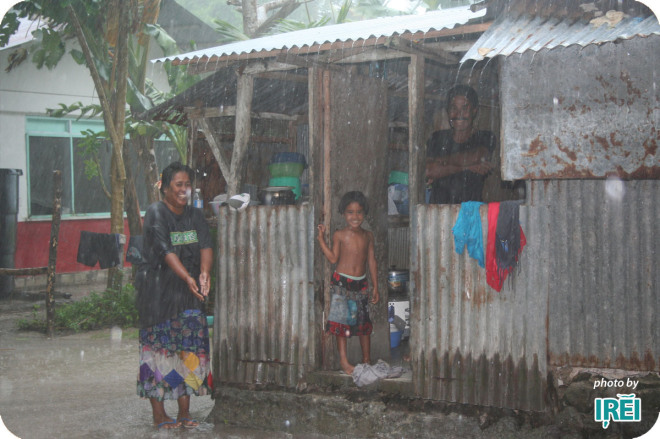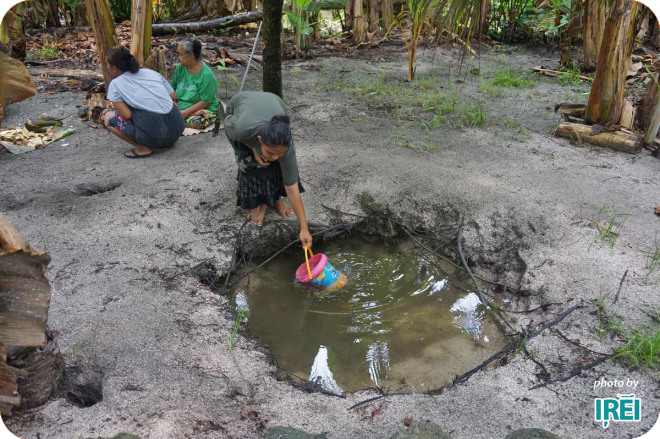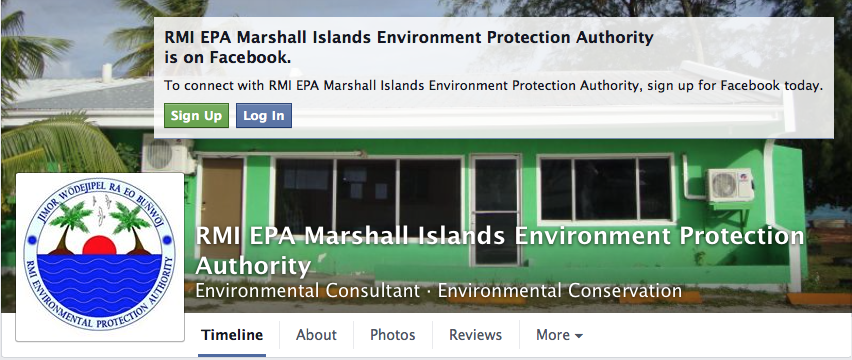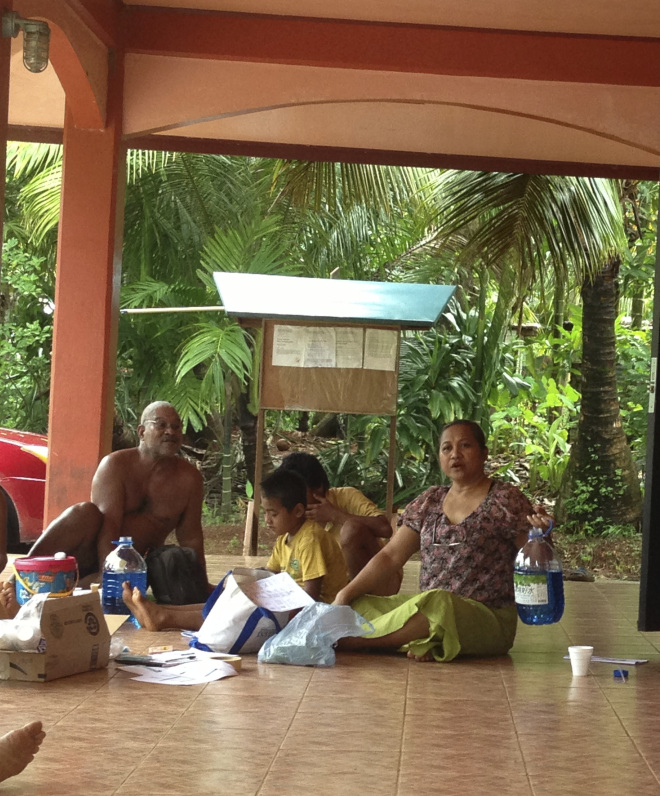Click on the picture or see: https://www.facebook.com/pages/RMI-EPA-Marshall-Islands-Environment-Protection-Authority/567859269972579?hc_location=timeline
Author: Water For Life

REFRESHING RAIN
I love this photo from Pakin atoll, one of the outer islands of Pohnpei. It is nice to see this family enjoy the refreshing and plentiful rain, especially considering that Pakin has been known to run out of fresh water supplies in the past. Hidden under vegetation in the atoll forest are remains of PVC pipes used to pump water from a relief ship to the island during one of the past droughts.
WATER RATIONING IN PALAU
[Pacific Islands Report briefs for Tuesday, October 15, 2013]
Palau Utilities Corporation Announces Water Rationing
Entirety of Koror, Airai to be restricted from 9 pm to 4 am
KOROR, Palau (Island Times, Oct. 14, 2013) – Palau Public Utilities Corporation (PPUC) yesterday issued an update on the water situation, announcing that the water will be shut down starting 9 pm until 4 am. across Koror and Airai. Earlier, PPUC had announced water would be restricted from 11 pm to 4 am, and only residents in Idid, Meketii, Ikelau, Dngeronger, Ngerbeched, Medalaii, Malakal and Meyuns would be affected. PPUC Water and Wastewater Operations Public Relations Coordinator John Kintaro Jr. said during the briefing yesterday that the Ngerkesewaol tank was nearly empty, necessitating rationing for all Koror and Airai. There are four tanks that distribute water to Koror and Airai, with Ngerkesewaol holding 1 million gallons and the other three holding about half that. Kintaro Jr. said water would be shut off for seven hours daily to ensure the tank is refilled by the others during the shutdown. He also said, since last week, the water level in the Ngerkesewaol tank has been decreasing significantly, and one or more leaks may be contributing to the problem. Kintaro Jr. also said PPUC is working day and night to monitor water levels and identify possible leaks, although none have yet been found. The public was also warned water color may change during rationing, and any water for consumption should be boiled before use. In February, water rationing was also implemented in parts of Koror after Ngerkesewaol tank water levels dropped drastically. Several leaks, which were then repaired, were identified as the cause.
NEW RESOURCES – FRESH WATER IN MICRONESIA GUIDE AND WATER CYCLE GRAPHIC
Check out the Resources page for these two latest new additions from Danko!
TEAMWORK – GARGEY FIRST FLUSH DIVERTER INSTALLATION
Good group turn out on a Saturday morning in Gargey to install the ‘first’ First Flush Diverter in Yap. Along with the WFL Core Team members, we had community members come to assist and also three Yap State Public Service Corporation staff (from their water division) donate their time and tools to assist. When we opened the old pipe on the catchment, we found rat fecal pellets…breeding place for leptospirosis! The community members cleaned out the pipes and we completed the installation. EPA will be monitoring the catchment water.
YAP WFL TEAM INSTALLS FIRST FLUSH DIVERTERS AND CONDUCTS COMMUNITY TRAINING IN GARGEY VILLAGE
On Saturday 9/14, the Yap WFL Team successfully installed the first of five first flush diverters at the typhoon shelter in Gargey village. In addition the the WFL Team members, community members and three staff from the Yap State Public Service Corporation spent their Saturday morning preparing the installation site and installing the diverter. Following the installation, on Monday 9/16, the WFL training team conducted a ‘Safe Drinking Water’ workshop for Gargey community members. Plans are now underway for the remaining diverters. Go Team Yap! Pix to come soon.088
WFL PRESENTED AT THE GLOBAL 2013 STEMX EDUCATION CONFERENCE
You can find the whole schedule of 177 presentations for the Global 2013 STEMx education conference – listed in terms of your local time zone! – at http://stemxcon.com/page/attending-schedule
A recording of the Blackboard Collaborate session about Water for Life that was presented there can be found at: https://sas.elluminate.com/site/external/jwsdetect/nativeplayback.jnlp?sid=2008350&psid=2013-09-20.1303.D.69D2D8A54FD5F1A28A4B466D9041A4.vcr

SHALLOW WELLS
The groundwater table tends to be very shallow on the low islands. People dig wells by hand and easily reach fresh water. This is especially true in the interiors of islands with taro patches, where the land surface is lower than around the island perimeter and groundwater is found practically at the land surface. On this photo we see a young Chuukese woman on the island of Piis-Panew, the only permanently inhabited low island in Chuuk Lagoon, grabbing water from a very shallow well. The women in the background are cleaning taro.







